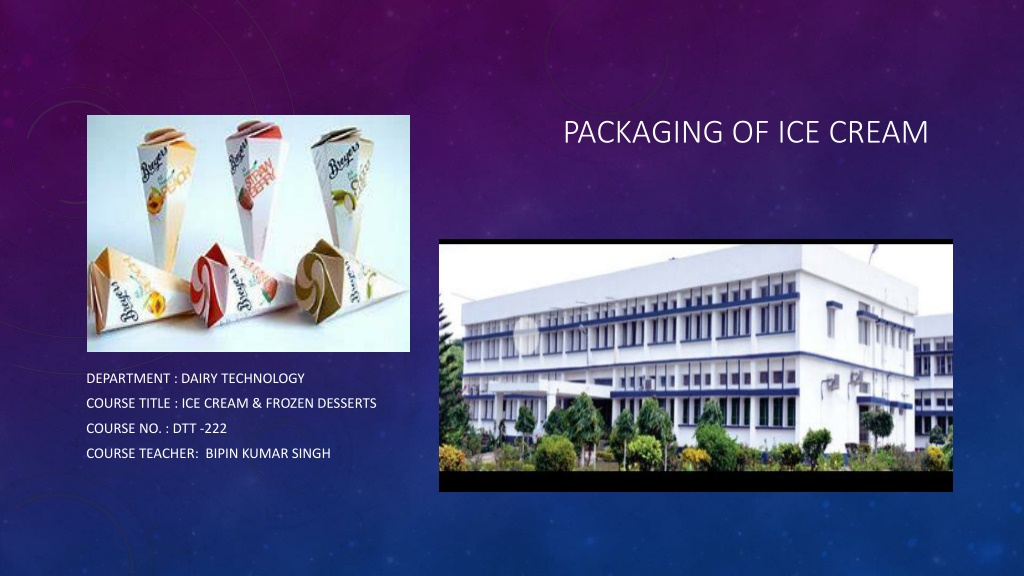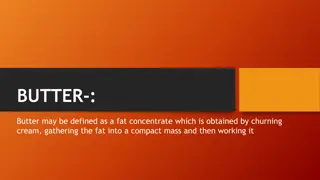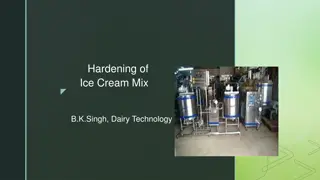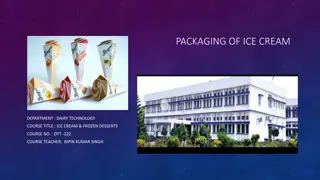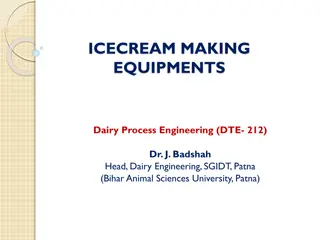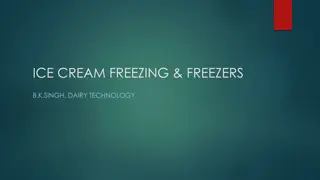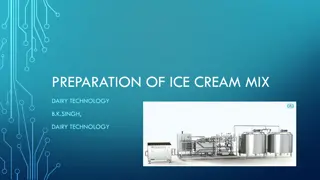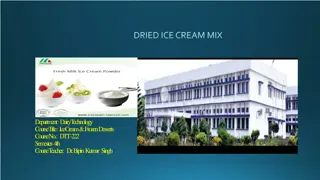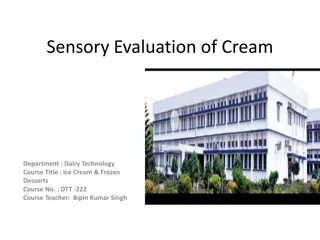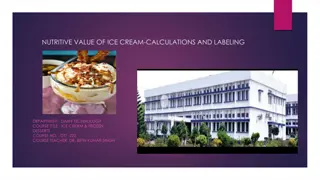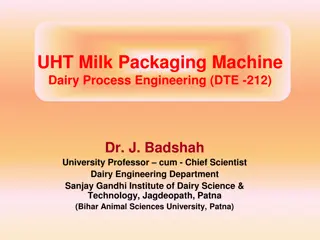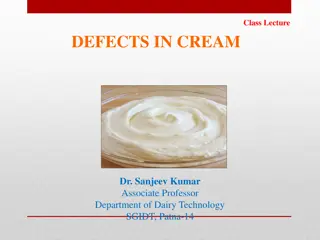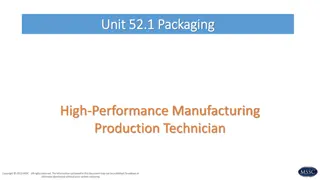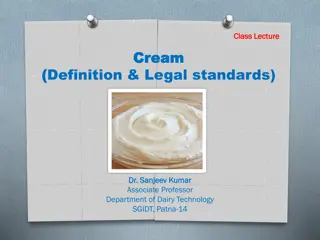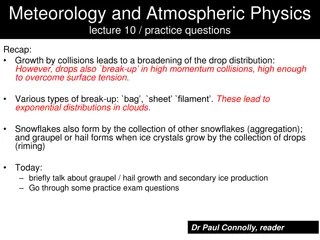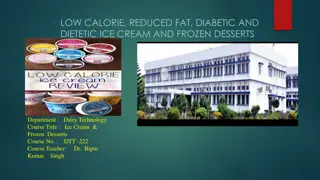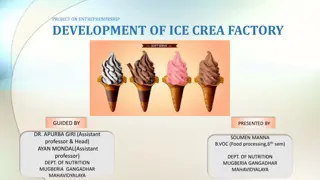Understanding the Packaging of Ice Cream in Dairy Technology Courses
Ice cream packaging involves selecting containers that ensure convenient handling, storage, and transportation. Factors like cost, protection against moisture loss, and appearance must be considered. Various types of packaging materials such as fiberboard, metals, plastics, and steel cans are used in the industry. Fiberboard containers and plastic (polyethylene) containers are commonly chosen for their strength, flexibility, and suitability for cold temperatures.
Download Presentation

Please find below an Image/Link to download the presentation.
The content on the website is provided AS IS for your information and personal use only. It may not be sold, licensed, or shared on other websites without obtaining consent from the author. Download presentation by click this link. If you encounter any issues during the download, it is possible that the publisher has removed the file from their server.
E N D
Presentation Transcript
PACKAGING OF ICE CREAM DEPARTMENT : DAIRY TECHNOLOGY COURSE TITLE : ICE CREAM & FROZEN DESSERTS COURSE NO. : DTT -222 COURSE TEACHER: BIPIN KUMAR SINGH
PACKAGING OF ICE CREAM When ice cream is drawn from the freezer, it is put into containers that give it the desired form and size for convenient handling storage, shipping and marketing processes. during the hardening,
FACTORS THAT NEED TO BE CONSIDERED IN SELECTION OF ICE CREAM CONTAINER Cost should be as minimum as possible Should be protective against moisture loss, Losses due to Temperature and contamination are as minimum as possible. Ease to handling and disposal (i.e.ease of opening and reclosure, if required) Should not effect upon the quality of ice cream Appearance should be neat. Package should provide all information as batch, date of manufacture and expire.. Storage problem. Point of consumption in relation to the location of the factory. Size of unit desired. Minimum damage during transportation.
TYPES OF PACKAGING Bulk containers i) Fiber board containers ii) Metals containers iii) Plastic (Polyethylene) containers Wrappers Plastic (polystyrene) or wax-coated paperboard Steel cans
FIBER BOARD CONTAINERS Corrugated fiberboard is a material consisting of a fluted corrugated sheet and one or two flat linerboards. It is made on "flute lamination machines" or "corrugators" and is used for making cardboard boxes. The corrugated linerboard(s) are made of kraft containerboard, a paperboard material usually over 0.01 inches (0.25 mm) thick. Corrugated fiberboard is sometimes called corrugated cardboard, although cardboard might be any heavy paper-pulp based board. medium sheet and the Fiberboard Boxes, Cartons and Containers Paperboard is a paper- like material, usually over ten "mills" (0.010 inch) in thickness. Some types of paperboard (corrugating medium and linerboard) are used in the construction of corrugated fiberboard. Other types of paperboard are used in the manufacture of cartons, set-up boxes, partitions and other products.
PLASTIC (POLYETHYLENE) CONTAINERS Hi-density Polyethylene, or HDPE, is a popular choice for both containers and lids. It is flexible, strong and impact resistant, and can be formulated to withstand cold temperatures very well. It is lightweight, which can be a consideration when shipping costs are considered. Plastic tubs are available for packaging ice cream, ranging in size from a few ounces for single serve portions, to several gallons for use in ice cream shops. These tubs are dimensionally stable, and work well with automated filling equipment. They can be printed in any number of ways: during the molding process; as they are going down the assembly line at the container manufacturer s facility; manufacturer s facility, either with direct printing, or with a label applied during filling. or at the ice cream
WRAPPERS Step-by-step instructions to dress up any ice cream cone with wrappers Print out the template of your choice. Standard printer paper should do the trick. Just be sure to print the proper template for your ice cream cone. There are different dimensions for sugar cones versus cake cones. Carefully cut your wrapper out of the desired template. guidelines. Wrap the sleeve around the ice cream cone. Use double-sided tape or a dot of glue to adhere the edges. Scoop your ice cream, add your toppings and enjoy!
PLASTIC (POLYSTYRENE) OR WAX-COATED PAPERBOARD These beverages (both with and without a corrugated sleeve), plastic- coated and wax-coated cups fluted paperboard clamshells (p. ES-16; pp. 2-60 through 2-63). The study also compared foam polystyrene plates with 9-inch high-grade molded pulp plates . include plastic-coated paperboard cups for hot for cold beverages, and 9-inch high-grade A wide variety of wax coated paperboard options are available to you, such as mechanical pulp, chemical pulp. You can also choose from specialty paper wax coated paperboard, as well as from offset printing wax coated paperboard, and whether wax coated paperboard is anti-curl, waterproof, or moisture proof.
METALS CONTAINERS A metal is a material that, when freshly prepared, polished, or fractured, shows a lustrous appearance, and conducts electricity and heat relatively well. Metals are typically malleable or ductile. A metal may be a chemical element such as iron; an alloy such as stainless steel; or a molecular compound such as polymeric sulfur nitride. Ice cream will melt faster in metal container because it is a heat conductor so it gives heat away and absorbs heat from surroundings.
STEEL CANS Stainless Steel Ice Cream Cans are an excellent alternative to plastic pails or cardboard tubs or boxes. Requirement of steel cans: a. 304 Stainless Steel b. No welds or seams to trap food c. Reusable and recyclable d. Empty cans nest together for space-efficient stacking
COMPOSITE COMBINATIONS FOR ICE CREAM PACKAGING There is an ample choice of composites for ice cream packaging. There will be multiple factors taken into account to select the best combination that suits both packaging needs and vision. Each packaging solution is created individually, some schemes are Composite combinations for ice cream packaging demonstrated below.
COMPOSITE COMBINATIONS FOR ICE CREAM PACKAGING SCHEME 1. Packaging based on transparent and metallized polypropylene films offers high protection for the chocolate coating the thin layer of aluminium foil provides good insulation from the environment, greatly improving shelf life and design options. oriented transparent polypropylene film (good barrier properties against water vapours, high transparency) oriented metallized polypropylene foil (good protection against moisture, reflects sunlight)
COMPOSITE COMBINATIONS FOR ICE CREAM PACKAGING SCHEME polypropylene film is ideal for ice cream packaging: it has a porous structure, which is light and looks extremely allowing for unrestricted design concepts. 2. Pearl-white foamed white, Pearl-white film condensate properties, high level of whiteness) polypropylene (good water blocking
COMPOSITE COMBINATIONS FOR ICE CREAM PACKAGING SCHEME 3. This is a single-layer laminate. Oriented transparent polypropylene film is used to emphasize the attractiveness of the product. oriented polypropylene film (good barrier properties against water vapours, high transparency) transparent
